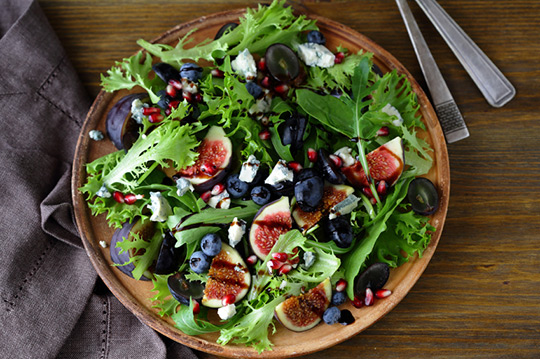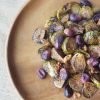
How to Have a Scrumptious Organic Salad and Save Money
By Linda Bonvie | 0 Comments | Posted 01/13/2016
By now you’ve seen the latest thing in instant salads. It’s called a “salad kit.”
These ready-to-fork veggie-kits are flying off the shelves, as salad lovers – and even newbies to the salad set – delight in having a designer combo contained within a single package.
A kit contains mixed, chopped and goodied-up salads-in-waiting in clear plastic bags, displaying assorted veggies and, most uniquely, small bags of extras that can include dried fruits, nuts, cheeses, and chips. Oh, and that obligatory packet of salad dressing.
But why rely on someone else’s idea of what makes a great salad kit and spend more on it? The truth is that it’s a breeze to hack this now trendy and healthy idea. What’s more, it lends itself to going far further than many of the mass-produced versions. You can easily make your own with fresher, organic ingredients that exactly fit your lunch-time mood on any given day…and save money doing so.
To start, it’s essential to go big on greens, which make up at least 80 percent of a kit. The main leafy players are iceberg lettuce, various cabbages, broccoli greens (not the flowerets), red and green romaine lettuce and kale.
The principal greens can be accompanied by the richer-flavored likes of collards, turnip greens, chard, spinach, mustard green, arugula, radicchio, watercress, chicory or endive – just to name a few. The trick with the more tangy greens is to use them sparingly. They’re meant to lightly compliment the flavor of the primary greens.
Tip: Wash greens before chopping, then pat dry or spin dry. Washing greens after chopping leaves too much residual moisture, even after a decent drying effort. Moisture is a kit’s worst enemy.
After cutting the greens to perfection, place in large bowl and tenderly toss with hands or forks. This is when you determine just how much salad you’ve chopped – and chopped salad can bulk up. It’s all good. One of the benefits of salad kits is their ability to stay fresh for a goodly amount of time when bagged and fridged.
Now, using a larger resealable plastic bag, jam in the chopped leafy greens. Fill bags fairly full — but remember, there’s more to come.
Now come the “fixins,” the extras that make this your own unique blend.
You can use virtually any and all dried fruits, mixed nuts, veggie slivers, shredded or crumbled cheeses (especially feta or goat cheese if you like the taste), crushed chips, dry spices, and smaller fresh fruits.
Important: Make sure to use a singular package for each of the fixins. Combining the likes of goat cheese and dried cranberries makes for a messing pour-out when a kit is being served.
Reclosable “snack bags” — those downsized bags that always seem a tad too small for most uses — are perfect.
It’s in the fixins bags that a kit’s health factor can be ramped up. Adding Wild Oats organic flax seed (ground or whole seeds home ground) and Wild Oats organic chia seeds enhances a salad’s flavor while adding astounding nutritional value. Such ultra-healthy add-ins can be included in a spice bag, along with the likes of ground pepper, sea salt and even celery seed.
The spice bag is where exotic touches enter the taste picture, via Cajun, Asian, Tex-Mex, or Mediterranean seasonings.
A fresh herb packet also bring uniqueness to a salad kit. Some perfect minced herbs are basil, lemon herbs (like lemon thyme), chives, dill, fennel, savory, chervil and tarragon. Herbs can also be placed in a single bag.
It then comes down to the salad dressing. Many a creative kit can be eaten with a bare minimum of dressing assistance. At the same time, a kit lends itself to homemade dressing blends. Just make sure the reclosable seal on the dressing bag is tight. Store-bought salad dressing packets also work well.
Finally, serving a kit is just a few pours away; transferring the greens to a bowl, followed by your own special extras.
And no doubt, you’ll be the envy of your plain sandwich-toting colleagues!


 Contact us
Contact us



























